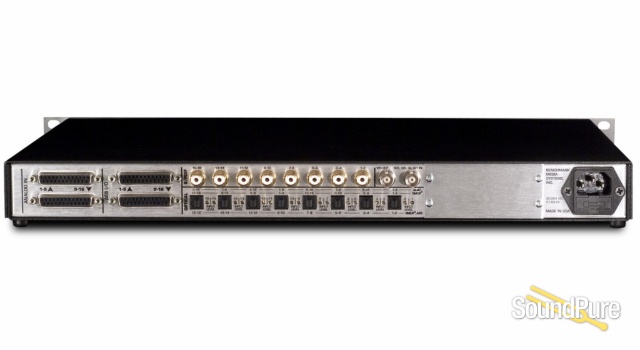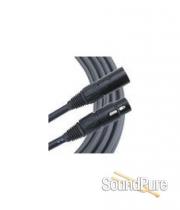-
Call Us Toll Free888-528-9703
-
Local/International (+1)919-682-5552
- Call Us! Toll Free! 888-528-9703
- Local / International (+1) 919-682-5552

Item selected is discontinued (details below). Related products available now:
Benchmark ADC16 16-Channel A/D Converter From Benchmark
16-Channel Analog to Digital Audio Converter
Manufacturer's Description from Benchmark
DAW Interface
The ADC16 has a slot for an optional Firewire card. With a Firewire connection to the computer, the ADC16 can operate as the sole interface to native DAW’s, including Pro Tools 9, without the need for any other hardware. Moreover, The ADC16 is completely compatible with the digital I/O interfaces of the Avid/Digidesign interfaces and other interfaces with AES, coaxial, and/or optical inputs.
The ADAT mode of the optical outputs makes the ADC16 a perfect companion for older Pro Tools LE interfaces, as well as other digital interfaces with ADAT and coaxial inputs, as it can fulfill the entire digital-input capability of the interface with state-of-the-art A/D performance.
This type of flexibility means the ADC16 can work perfectly with DAW setups from the past and the future.
The ADC16 features 16-channels of transformerless balanced analog inputs. The analog front-end continues Benchmark’s tradition of exceptionally pristine, award-winning analog circuitry – a legacy that dates back to the early 1980's.
Each channel of analog input has a gain control (via a trim-pot) that has a 20 dB range. At 0 dB of gain, it can accept 28 dBu at the input without clipping. At max-gain, an 8 dB input-signal will drive the converters to full-scale.
The ADC16 features three separate 16-channel output groups:
- Balanced AES/EBU (16 channels at all sample rates)
- Coaxial AES (16 channels at all sample rates)
- Optical (AES or ADAT) (16 channels at all sample rates and formats)
There are two sources available for each output group:
- A/D output (16 channels)
- DAW return (16 channels)
The control panel allows the assignment the source groups (A/D or DAW) to the output groups (AES, Coaxial, or Optical). This is very useful when the ADC16 is used in a studio with an analog console. The digital audio from the A/D chips can be sent directly to the digital outputs to a multichannel D/A to feed the console – completely bypassing the DAW while tracking. This reduces latency and DAW artifacts in real-time monitoring. At a press of a button, the return channels from the DAW can be routed to the same outputs for mixing.
The eight optical outputs on the ADC16 can be operated in SPDIF or ADAT mode at sample-rates up to 192 kHz (ADAT has SMUX2 and SMUX4 functionality).
UltraLockDDS™ - Jitter-Immune Clock System
The clock performance of the ADC16 never varies. Benchmark’s new UltraLockDDS™ clock system utilizes the latest low-jitter clock technology leveraging systems developed for high-frequency RF communications.
The master oscillator is a low phase-noise, temperature-compensated, fixed-frequency crystal oscillator with a +/- 2 PPM frequency accuracy. The frequency accuracy and stability of the ADC16's oscillator makes it well suited to operate as the master clock for the entire studio. However, if an external master clock is available, the ADC16 can be slaved to the external clock without any performance penalty.
This ADC16's internal oscillator drives a 500 MHz Direct Digital Synthesis (DDS) system that generates a 3072 x WC system clock. This high-frequency clock is divided by 6 and distributed directly to the A/D converters using a high-speed PECL clock distribution chip. Each of the 8 converters are driven directly from a dedicated, matched-impedance transmission line.
Jitter attenuation is achieved with digital filters in a custom FPGA that controls the DDS system. All jitter-induced distortion artifacts are well below audibility under all operating conditions. Jitter-induced distortion is always at least 135 dB below the level of the music. The jitter-performance of UltralLockDDS™ meets or exceeds the performance of Benchmark’s UltraLock™ system, but does not use asynchronous sample rate conversion (ASRC). The elimination of the ASRC processing significantly reduces system latency and provides the most direct path from the A/D to the digital interface.
Benchmark’s UltraLockDDS™ system is frequency agile. It can lock to any sample rate between 28 kHz and 200 kHz, and it can do so in a few milliseconds. Special pull-up and pull-down sample rates for film to video transfers are no problem. Best of all, jitter is always attenuated to levels that are well below audibility. Jitter performance is identical in all modes of operation.
16-Channel Meter Bridge
The ADC16 features 9-segment meters for each channel. These meters are single-sample accurate, so that even the shortest peaks are registered. The meters can be set to display in 6 dB increments (48 dB range) or 1 dB increments (20 dB range). In both cases, the meters can be put in ‘peak-hold’ mode, which will hold the highest-valued sample until the ‘peak-hold’ mode is reset.

About Manufacturer
Long time manufacture of sought after digital converters, have quickly become a top player in the business with the release of their new DAC1 Digital to Analog Converter. With new A to D converters and mic preamps on the way, we plan to keep our eye on them!
Specifications
|
SNR – A-Weighted, 0 dBFS = +16 to +29 dBu |
121 dB |
|
SNR – Unweighted, 0 dBFS = +16 to +29 dBu |
119 dB |
|
SNR – A-Weighted at max gain, 0 dBFS = -10 dBv |
117 dB |
|
THD+N, 1 kHz at –1 dBFS |
-102 dBFS, -101 dB, 0.00089% |
|
THD+N, 1 kHz at –3 dBFS |
-107 dBFS, -104 dB, 0.00063% |
|
THD+N, 20 to 20 kHz test tone at –3 dBFS |
-105 dBFS, -102 dB, 0.00079% |
|
Frequency Response at Fs=192 kHz |
-3 dB, +0 dB, 2 Hz to 94 kHz +/- 0.02 dB, 20 Hz to 20 kHz |














